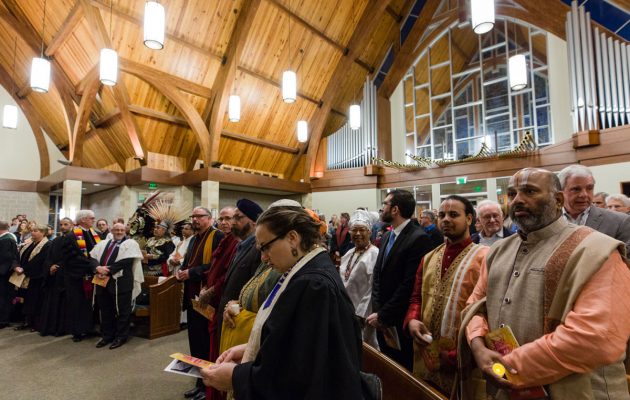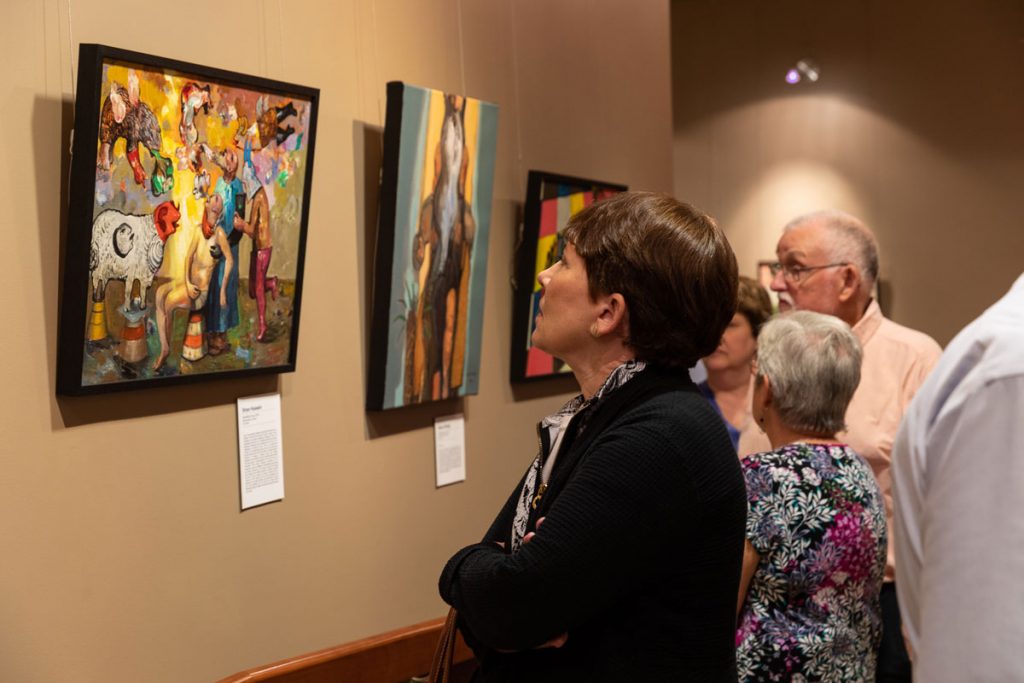Hendricks Avenue Baptist Church: 75 years young and still growing
Posted on December 7, 2021 By Editor Top Stories

From its very beginning Hendricks Avenue Baptist Church (HAB) members have focused on how their church is being called to serve its members and the local community. The original members split from two other congregations – Faith Temple and Southside Baptist Church – and agreed to form a single church in 1945 in space they rented from the Little Theatre in San Marco. They initially wanted to call themselves Calvary Baptist Church, but soon learned that there was already a church with that name in Jacksonville.
With their decision to build a new church came a new name. A member, W.K. Hatcher, offered to purchase 14 acres of land on Hendricks Avenue beyond Oriental Gardens near the end of city development along a narrow, blacktopped State Road 13, not wide enough for two cars to pass comfortably. His one condition was that the congregation would have to match his contribution with funds going toward building the first structure.
The church was built on a vision, as much or more than it was on land. The young church claimed to be “a new Church founded with old ideals and a new idea, that of offering to children and young people a Church that is a place of worship and also a community center … We are convinced that no church has a moral right to close its doors during the week and then complain about young people going to other places for their social and recreational life.”
And so, the members built first not a sanctuary but a gymnasium. It became the foundation of the church’s recreation program that still is fundamentally important to its mission today.
HAB’s first service was led by Dr. C.M. Coalson, on Sept. 22, 1946. In October of 1946, when the Jacksonville Baptist Association met in October 1946, HAB reported eight baptisms. On May 16, 1947, William G. Power joined the church as its 100th member. HAB’s first wedding was when Power married Betty Crovatt 15 days later on May 31, 1947.
Member Robert F. Darby, son of HAB founding member, Fred Darby, and an architect with Reynolds, Smith and Hills, designed the church’s first sanctuary. Ground was broken on Jan. 6, 1957, and the first service was held on March 16, 1958.
True to its original vision to be a gathering place for neighborhood children, the Hendricks Avenue Baptist Recreation Association was established in June 1958, led by Robert Carnes, first full-time recreation director for HAB. Ball fields were created and within 18 months, 398 youth were engaged in various sports offered by the program.
The sports were open to anyone in the community with these requirements: Be at least nine years old, pay a fee of one dollar per year and agree to adhere to the rules of Christian conduct. The program has been led by volunteer, not paid, recreation directors. Some are Harvey Jay, Mrs. C.G. Jones, Jim Abercrombie, George Clements and Randy Weathers.
The recreation program changed to Hendricks Avenue Community Athletic Association (HACAA), a non-church owned organization in 1986. That allowed the program to receive funds and support from the City Recreation Department and be controlled by a board of directors. HACAA has been the springboard for a number of professional athletes, such as Dee Brown, David Treadwell, Rick Wilkins and John Callhan.
One long standing mission of the church has been its work with internationals, teaching them both conversational English and citizenship classes. April 15, 1966, Christine Garnett, a former missionary to Cuba, started a Bible Fellowship at HAB with 12 Cubans. Two key figures involved in the international program were the Rev. and Mrs. Phil Maxwell, who moved to Jacksonville from Tallahassee in September 1968. During a typical year, they led English classes for 100 students from 27 nations. This ministry led to a Baptist Mission for Koreans in 1980.
HAB is also unique among Baptist churches in its promotion of women leaders.
“In the Baptist tradition, women and men have not always been recognized equally,” said Dr. Kyle Reese, HAB’s pastor from 1980 to 2000. “We began electing and ordaining women in the late 1980s.”
In 1986, Ann Carter, Anne Birchfield, Evelyne Hanson, Sylvia McQuaig, Nannie Paul Thomas and Corinne Williams were the first females to be elected and ordained. Irene Albritton, a hospital chaplain, was the first woman ordained to the ministry by HAB. In 1990, Cheryl Warner was the first woman elected as a deacon officer, vice chair and the first to woman to administer Communion. In 1996, Mary Wood became the first female deacon chair.
“Hugh and I joined HAB in August 1987 after we moved here from Nashville,” said Susan Greene. Hugh Greene, an ordained minister, retired from Baptist Health in 2019, where he had been an executive since 1989 and CEO for 20 years.
“We were told when we moved here that there would be one church for us – HAB. We had 3 young sons and we drove in from the Beaches to go to attend,” Susan said. “We joined because HAB is a progressive Baptist church – part of the Cooperative Baptist Fellowship (CBF). We are an embracing church. We respect all faith traditions.”
Susan has also been involved in the church’s international outreach. While serving on the board of the then-YWCA, she took training to learn how to teach English to refugees. She taught classes for seven years with nearly 40 other volunteers. They taught Bosnian, Sudanese and Burmese refugees being resettled in Jacksonville by Lutheran Social Services of Northeast Florida.
“We could feel and know what was happening around the world by who was literally coming to our front door,” she said.
HAB’s most widely visible moment was when the original sanctuary was destroyed by fire on Dec. 23, 2007. The fire began in the early morning hours and burned undetected until it was impossible to prevent it from consuming the building.
The next day, Christmas Eve, the members had worship in the Family Life Center, which didn’t burn in the fire. At the end of worship, All Saints Episcopal Church members came in and announced they had lunch for the members. Other churches helped as well, by loaning them music and choir robes. HAB member Joyce Hanson recalled that a Jewish young lady and her family bought the church pew bibles.
“The fire pulled the community into HAB and HAB even further into the community,” Hanson said.
The new sanctuary’s official opening was Dec. 23, 2009, exactly two years after the fire. The choir performed Messiah, the same music that had been performed the night before the sanctuary burned down.
HAB developed a reputation as an ecumenical church eager to work with others – Catholic, Protestant, Jewish and Islamic. Its pastors have had a strong sense of the importance of community participation and involvement in roles outside the pulpit.
“HAB began interfaith cooperation in the 80s,” Reese said. “Our members would serve as ushers at the temple on High Holy Days, and their members would do the same for us on Christmas and Easter. Before the Islamic Center got a building of its own, it used a Sunday School room at HAB for Friday prayers.”
If you have happened to drive along Hendricks Avenue between Ash Wednesday and Good Friday any year since 1983, you may have noticed large wooden crosses draped in royal purple until Good Friday when they are changed to black for mourning and then in white on Easter Sunday morning. That tradition began with HAB and inspired All Saints Episcopal and St. Mark’s Lutheran to construct their own crosses.
That cooperative effort led the three congregations to begin an annual celebration of Palm Sunday. In 1985, the three choirs and congregations gathered on the lawn in front of HAB’s gym for a Palm Sunday service and then processed with palm fronds into their separate sanctuaries.
HAB’s most recent community outreach is the HAB Art Gallery, which opened in 2009. The gallery features both permanent and rotating exhibits year-round. Susan Greene was part of the Art Ministry Team that planned the HAB Art Gallery.

“It became very meaningful to see how art opened up new questions and new thoughts and led to conversation,” she said. “We have had people from multiple cultures involved.”
In 2013, the church also established HAB Ambassadors to welcome and engage with the more than 25 groups that meet on its campus. The HAB Community Garden was also created that year.
“From its very beginning, HAB has had the community on its mind,” Reese said. “When I came it was a perfect match. I wanted to be active in the community, and HAB pushed me to be more active than I ever thought possible. It was a great gift to me.”
B.J. Hutto was called as HAB’s pastor in 2020, just as in-person church services and activities had been suspended due to the COVID-19 pandemic. His wife, Rev. Rebekah Hutto, a Presbyterian minister, and he, along with their daughter, Hannah Ruth, and son, Elijah, live in San Jose.
“I’ve been here just over a year, and during that time we haven’t been able to get everybody together in the room at the same time,” Hutto said. “What I’ve seen so far, though, is a church that is careful, considerate and willing to go the extra mile to take care of its members and the people surrounding it. It’s a church that really values fellowship.”
“Since I have arrived at HAB. I keep meeting interesting and interested young adults. People are always going to want to go to a place where they will be loved, where they can come together and investigate interesting, critical questions in life.”
Robert Hill Jr. and his wife, Margaret, joined HAB about 20 years ago when they moved their family from Tennessee to Jacksonville. Hill is the former president and CEO for Acosta Sales & Marketing Co.
“Margaret and I both served as deacons, and out children participated in mission programs,” Hill said. “The church has a history of strong, pastoral leaders serving in the community as well as in the church. It has a great leader in Pastor Hutto.”
“The church will continue to change,” he said. “It will be flexible in its ministry and will adapt to members’ level of comfort by reaching people appropriately and beyond its walls as needed.”
By Karen Rieley
Resident Community News




 (No Ratings Yet)
(No Ratings Yet)B.J. Hutto, C.M. Coalson, HAB, HAB Art Gallery, HACAA, Hendricks Avenue Baptist, Kyle Reese, Robert Carnes, Robert Darby, Susan Greene, W.K. Hatcher





